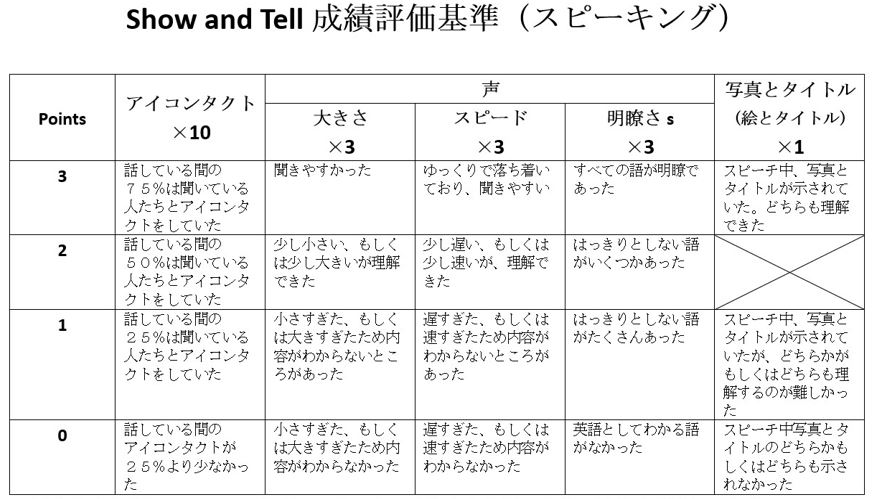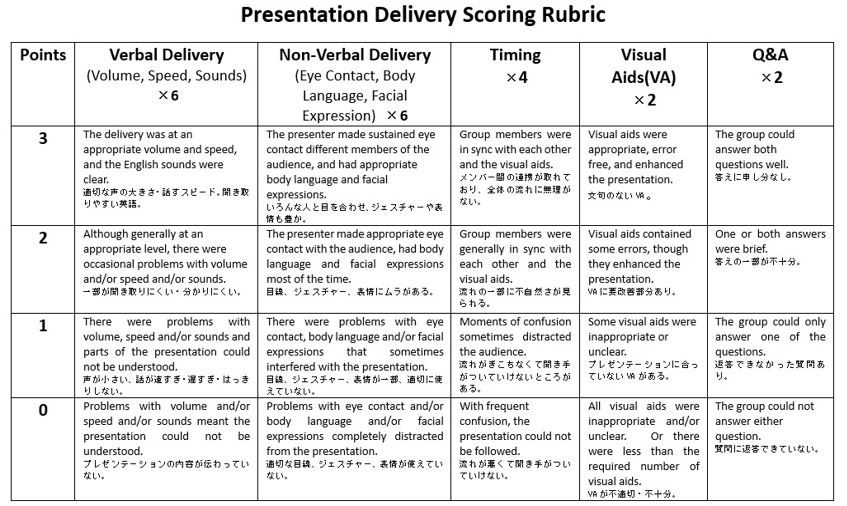スピーキングの評価について

中1から高3まで全てのEIPの授業では、スピーキングのテストがはじまっています。テストの内容は、学年によって異なります。また、それぞれのテストにおける視点もそれぞれ異なってきます。中学1年生の段階では、アイコンタクトや声の大きさといった、簡単なことが評価の対象となりますが、中学3年生になると、質問をする、より長い文で答える、自らすすんで聞く等、たくさんのポイントが会話のスキルとして挙げられます。また、高校生になると、より高い得点をとるには、論理的に自分の意見を説明できるかどうかも問われます。
上記に挙げたような違いはありますが、すべての学年、テストを通して共通していることは、ルーブリック評価を用いていることです。ルーブリックでは、「この評価を得るためには何が必要か。」ということが、細かく記されています。
お子さまが成績を受け取ったときに、なぜその成績なのかを理解し、どうすれば次回につながるかを考えるきっかけになれば幸いです。
Evaluating Speaking
In all the EIP lessons across all six grades of the junior and senior high school, we are starting or have started conducting speaking tests. The content of the tests varies depending upon the grades: junior high school first years will be giving show and tell speeches, second years will be explaining what they will take in their suitcase when they travel abroad and other tasks, and junior high school third years will be having conversations in pairs. In the high school, first years will play the discussion-based board game they have been playing in lessons, and the high school second years are currently giving presentations on 3-day trip plans for visitors to Kansai. Also, the focus of each test is a different. For example, in the first-year junior high school test, simple things like eye contact and volume are evaluated. In the third-year test, a lot of points are given for conversation skills, such as asking questions, giving longer answers and listening actively. In the first year of high school, the English students use to logically explain their choices is required to get the highest scores on the test.
Despite all the differences above, one thing that is consistent among all the tests is that they are evaluated using rubrics. In a rubric, what is necessary for a certain score in each category is describe. For instance, in the high school first year test, to get the maximum score of three points, the students must “use a range of appropriate grammatical structures accurately.” If they use a range, but there are many mistakes, they can only get two points. If they only use simple structures, they can only get one point. If they cannot use simple structures accurately, then they cannot receive any points in the grammar category. Finally, some categories are more important than others, so we multiple each by a certain number. In the junior high school first grade, making eye contact is multiplied by 10, meaning the maximum score is thirty points (3x10). This is actually 50% of the total score! While this seems a lot, making eye contact while speaking English is a particularly weak point for some students speaking English, so we wanted to reward it. Also, by prioritizing it early, we hope to produce students whole confidently share their ideas with others in English when they are in the later grades.
We hope that when your children receive their test scores, they will understand through the rubrics why their results are fair, and what they need to do to improve next time.
(中高校教諭 スティーブン スワン)


